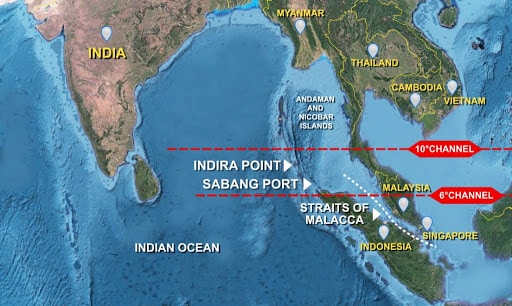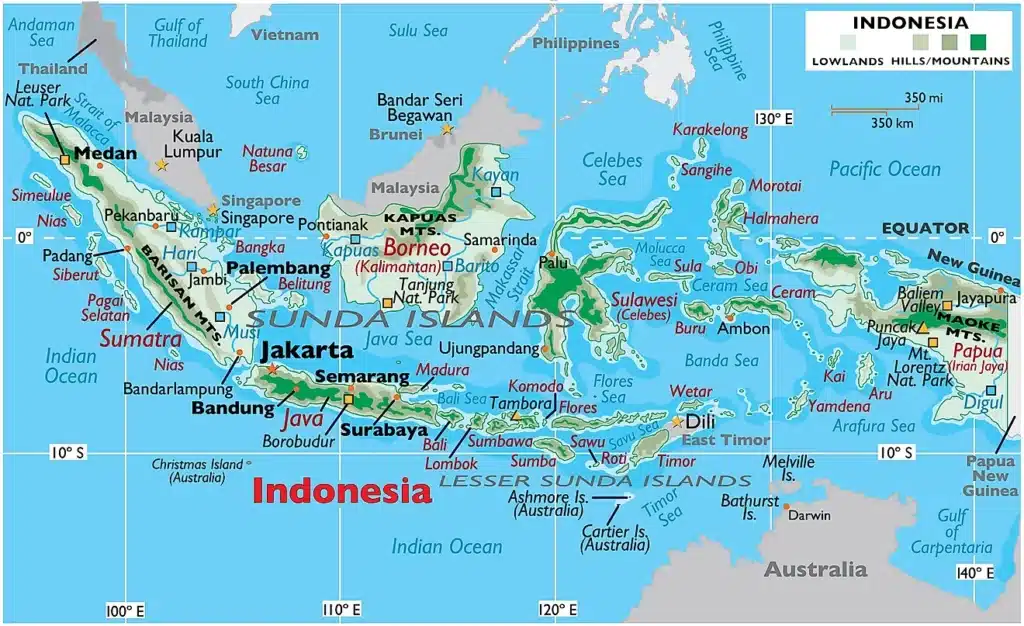Indonesia is the World’s largest Island Country with more than 17,000 islands. It has the 4th largest population in the world. It is the country having the highest Muslim population, India is ranked at 2nd position for the same. World’s most populous island in the world is Java, it is in Indonesia.
India and Indonesia have shared two millennia of close cultural and commercial contacts. The Hindu, Buddhist and later Muslim faith travelled to Indonesia from the shores of India. The Indonesian folk art and dramas are based on stories from the great epics of Ramayana and Mahabharata. The shared culture, colonial history and post independence goals of political sovereignty, economic self-sufficiency and independent foreign policy have unifying effect on the bilateral relations.
The national leaderships of India and Indonesia led by Jawaharlal Nehru and President Sukarno collaborated closely in supporting the cause of independence of Asian and African countries, and later laid the foundation of the Non-Aligned Movement at the Asian-African Conference held in Bandung in 1955. Since the adoption of India’s ‘Look East Policy’ in 1991, there has been a rapid development of bilateral relations in political, security, defence, commercial and cultural fields.
The multi-faceted relationship got an added fillip with the signing of the ‘Joint Declaration on Establishing a Strategic Partnership’ in 2005 during the State Visit of President Susilo Bambang Yudhoyono.
This can be witnessed in elevation of bilateral relationship between the two countries to the level of Comprehensive Strategic Partnership in May 2018 and creation of new mechanisms like bilateral security dialogue, trilateral dialogue and signing of an enhanced Defense Cooperation Agreement.

Areas of Cooperation
Economic and Commercial Relations
- As the largest ASEAN state accounting for over 37% of population and over 33% of combined GDP, and as a fellow member of G-20, Indonesia is of particular interest to India.
- Indonesia has emerged as the largest trading partner of India in the ASEAN region. Bilateral trade has increased from US$ 4.3 billion in 2005-06 to US$ 17 billion in 2016-17.
- India is the second largest buyer of coal and crude palm oil from Indonesia and imports minerals, rubber, pulp and paper and hydrocarbons reserves.
- India exports refined petroleum products, maize, commercial vehicles, telecommunication equipment, oil seeds, animal feed, cotton, steel products and plastics to Indonesia.
Security Ties
- The close defence relations between Indian and Indonesia have been growing steadily with regular joint activities and exchanges of personnel between the Armed Forces of the two countries. The two signed a strategic partnership agreement in 2005 that started an annual strategic dialogue. The next year, they ratified a defense cooperation agreement, initially signed in 2001, which focused on areas of defense supplies and technology, as well as on joint projects.
- Their joint statements began to condemn terrorism in all forms and call all nations to work towards eliminating terrorist safe havens and infrastructure, disrupting terrorist networks and their financing channels and stopping cross-border terrorism.
- Both nations want to emerge as major maritime powers. Also, Indonesia will provide India access to the strategic island of Sabang at the northern tip of Sumatra and close to the Malacca Strait. This would help India to become a net security provider in the Indian Ocean region.
- Bilateral Exercises:
- Exercise Samudra Shakti is a bilateral maritime exercise.
- Garuda Shakti is a joint military exercise between India and Indonesia.
Diaspora and Cultural Relations
- There is an active cultural exchange between the two countries . The Indian Mission operates Jawaharlal Nehru Indian Cultural Centre (JNICC) which conducts regular classes of Indian classical music, Indian classical dances (Kathak and Bharatnatyam), Yoga, and also teaches Hindi and Tamil languages.
Sahabat India
- The Festival of India in Indonesia’ was inaugurated on 26 January 2015 by Her Excellency Ms. Megawati Soekarnoputri, former President of Indonesia. During the Festival of India, more than 35 different events such as folk dances, dance drama, etc. were organized in several prestigious locations in Jakarta. There are around 100,000 Indonesians of Indian origin in Indonesia mostly concentrated in Greater Jakarta, Medan, Surabaya and Bandung. They are mainly engaged in trade dealing in textiles and sports goods.
Indian Ocean Region
- The Indian Ocean littoral states have also witnessed sustained growth over the past few years. Given the growing volume of bilateral maritime trade and a common maritime boundary along the Andaman Sea, India and Indonesia are natural partners in ensuring the development and security of the Indian Ocean and the pacific littoral region.
- All trade routes and the sea lanes must be protected from traditional and non-traditional threats and all countries using these international waters must act with responsibility and restraint.
- Indonesia’s idea of a Maritime Axis and India’s commitment to the Mausam Project which links the countries of the Indian Ocean can bring benefit to all the Indian Ocean Countries.
- India and Indonesia are one of the founder members of the Indian Ocean Rim Association, the apex pan-Indian Ocean multilateral forum and Indonesia is its current chair. Indonesia, given its strategic location, can be a bridge between the Indian and the Pacific Oceans. As one of the most important countries of the Asia-Pacific rim- Indonesia is in an advantageous position to connect a vibrant South Asia to the Pacific region.

Challenges in India-Indonesia Relations
- Even after the Comprehensive Economic Partnership with India, Indonesia would be hesitant to go against China’s interests due to its close relationship with China since the Cold War.
- After independence, India had good relations with Indonesia because both countries were founders of the Non-alignment movement; however, these relations deteriorated later as India leaned toward the USSR and Indonesia leaned toward the US. Indonesia backed Pakistan during India’s war with Pakistan.
- The demarcation of the two countries maritime borders in the Andaman Sea has not been completed. During the visit, however, both parties reiterated their intention to resolve the matter as soon as possible.

Nice work